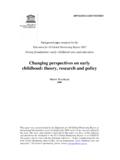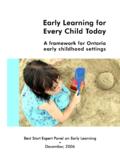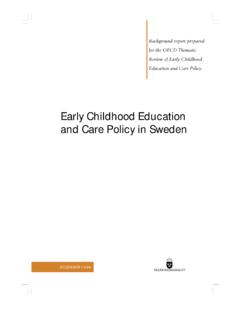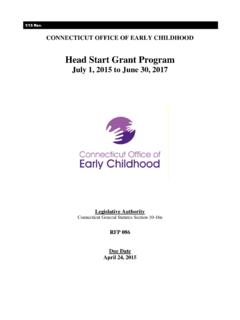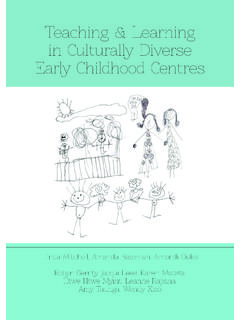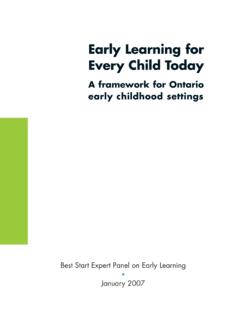Transcription of Primary Early Care and Education Arrangements …
1 Primary Early care and Education Arrangements and achievement at kindergarten EntryNCES DEPARTMENT OF EDUCATIONP rimary Early care and Education Arrangements and achievement at kindergarten EntryJUNE 2016 Amy RathbunAnlan ZhangAmerican Institutes for ResearchThomas D. SnyderProject OfficerNational Center for Education StatisticsNCES DEPARTMENT OF Department of Education John B. King, Jr. SecretaryInstitute of Education SciencesRuth NeildDeputy Director for Policy and ResearchDelegated Duties of the DirectorNational Center for Education StatisticsPeggy G.
2 CarrActing CommissionerThe National Center for Education Statistics (NCES) is the Primary federal entity for collecting, analyzing, and reporting data related to Education in the United States and other nations. It fulfills a congressional mandate to collect, collate, analyze, and report full and complete statistics on the condition of Education in the United States; conduct and publish reports and specialized analyses of the meaning and significance of such statistics; assist state and local Education agencies in improving their statistical systems; and review and report on Education activities in foreign activities are designed to address high-priority Education data needs.
3 Provide consistent, reliable, complete, and accurate indicators of Education status and trends; and report timely, useful, and high quality data to the Department of Education , the Congress, the states, other Education policymakers, practitioners, data users, and the general public. Unless specifically noted, all information contained herein is in the public strive to make our products available in a variety of formats and in language that is appropriate to a variety of audiences. You, as our customer, are the best judge of our success in communicating information effectively.
4 If you have any comments or suggestions about this or any other NCES product or report, we would like to hear from you. Please direct your comments toNCES, IES, Department of EducationPotomac Center Plaza (PCP) 550 12th Street, SWWashington, DC 20202 June 2016 The NCES Home Page address is NCES Publications and Products address is report was prepared for the National Center for Education Statistics under Contract No. ED-IES-12-D-0002 with American Institutes for Research. Mention of trade names, commercial products, or organizations does not imply endorsement by the CitationRathbun, A.
5 , and Zhang, A. (2016). Primary Early care and Education Arrangements and achievement at kindergarten Entry (NCES 2016-070). National Center for Education Statistics, Department of Education . Washington, ContactThomas D. Snyder SUMMARYEXECUTIVE SUMMARYY oung children experience various types of Early care and Education environments the year before they enter kindergarten . Some children attend center-based Arrangements such as preschools, childcare centers, or Head Start programs, while others are cared for in relatives or nonrelatives homes or are normally cared for only by their parents (Denton and Germino Hausken 2000; Snyder and Dillow 2016).
6 Prior research indicates that children s participation rates in specific types of Primary care Arrangements and their knowledge and skills at kindergarten entry differ in relation to certain characteristics of children and their families, including age at kindergarten entry, race/ethnicity, Primary home language, and mother s educational attainment (Denton and Germino Hausken 2000; Mulligan, Hastedt, and McCarroll 2012). Earlier research also finds evidence of positive associations between participation in Early care and Education (ECE) Arrangements and academic skills around the time that children begin kindergarten (Bradley and Vandell 2007; Denton Flanagan and McPhee 2009; Magnuson et al.)
7 2004; NICHD Early Child care Research Network 2002).This Statistical Analysis Report builds upon prior work by using the most recently available data to explore relationships between children s Primary care and Education Arrangements the year before kindergarten and their academic skills and learning behaviors at kindergarten entry, after accounting for child and family background characteristics. In the report, ECE Arrangements are classified into five groups: (1) center-based care (including day care centers, Head Start programs, preschools, prekindergartens, and other Early childhood programs), (2) home-based relative care , (3) home-based nonrelative care , (4) multiple Arrangements ( , children who spent an equal amount of time in each of two or more types of Arrangements ), and (5) no ECE arrangement on a regular basis ( , children who had no regularly scheduled care arrangement and mainly received care only from their parents).
8 Information for this report comes from the nationally representative National Household Education Surveys Program (NHES) and the Early Childhood Longitudinal Study, kindergarten Class of 2010 11 (ECLS-K:2011) data collections. Data from the NHES cross-sectional sample survey are used to describe trends in participation in ECE Arrangements that children experience prior to kindergarten entry. The NHES Early Childhood Program Participation (ECPP) surveys gather information on children s participation in ECE programs and the characteristics of these Arrangements .
9 Parents reported information on their child s participation in different types of ECE Arrangements in 1995, 2001, 2005, and 2012. This report compares estimates of 4- and 5-year-old children s Primary ECE Arrangements prior to kindergarten entry in 1995 and 2012. Estimates are presented overall and by children s race/ethnicity, their family s poverty status, and their mother s educational attainment. Data from the ECLS-K:2011 longitudinal sample survey are used to explore relationships between Primary ECE Arrangements the year before kindergarten and academic skills and learning behaviors at kindergarten entry.
10 The ECLS-K:2011 collects detailed information on the school achievement and experiences of students from the 2010 11 kindergarten school year through the spring of 2016, when most of them are expected to be in fifth grade. In the fall of 2010 and spring of 2011, parents reported information on child and family characteristics and their child s participation in ECE settings the year before kindergarten ; children were assessed in reading, mathematics, and cognitive flexibility; and kindergarten teachers reported on children s approaches to learning. The report describes the distribution of Primary ECE Arrangements that first-time kindergartners attended in the year before entering kindergarten in the fall of 2010, ivEXECUTIVE SUMMARY including differences in Primary ECE Arrangements by characteristics of children and their families.











